Tidepool Tales and Kelp
Tidepool Tales and Kelp
You don’t have to get into the water to notice the tremendous increase in the kelp forest off Laguna over the last year. A number of groups including thousands of individuals have been involved in the restoration of the giant kelp over the past few years. These efforts combined with good environmental conditions have contributed to the current healthy kelp habitat. A healthy kelp forest is vital to our marine habitat- over 800 different species rely on them.
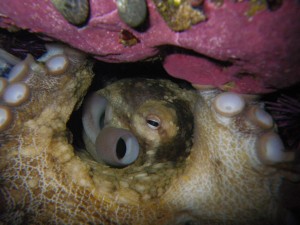
If you do get in the water and go snorkeling or diving, you’ll notice that it’s not just the giant kelp (Macrocystis pyrifera), but many other kelp species are thriving. There’s so much kelp in some places I have a hard time finding some of my favorite spots when I’m out snorkeling. I no longer can find a hole where I would usually spot an octopus- there’s just too much kelp around there to find the rock features that surrounded the octopus den.

There’s a natural bowl with a crack at the bottom where I can usually find moray eels
(I once saw 3 in there!) but it’s hard to find because of all the kelp growing in that area. Also swimming now has the added challenge of zig-zagging around the kelp. These are small prices to pay for the enormous benefits that the kelp brings to our marine habitat. I certainly don’t want to go back to the days of clear, unobstructed views of the urchin barrens.
The increase in the kelp should lead to an increase in all the species that rely on kelp for a food source and shelter. When I swim out to the kelp forest I know I see a lot of fish hanging around- opal eye, kelp bass, senoritas, sargo, sardines and many others. Just the other day while out swimming near the kelp bed, I was surrounded by 100-200 yellowtail or white sea bass (sorry, I’m not that good at identifying fish). The visibility was maybe 10-15 ft so I couldn’t see that far, but I was in the middle of a big school of fish, some over 2 ft long.
The seals, sea lions, and dolphins seem to like the kelp forest as well- or more likely they’re attracted to all the fish hanging out in the kelp. I’ve had a few encounters with playful, curious harbor seals while swimming near the kelp.
This one played with us for half an hour until we got cold and had to leave. If you go out kayaking or paddle boarding to the kelp forest you’re likely to have an encounter with one of our local marine mammals.
There’s a danger to the kelp forest lurking out there. Sea urchins are voracious consumers of kelp and unfortunately, the sea urchin population is out of control. I know in the last 6 months I have watched an explosion of urchins grow from small to medium on the rocky points surrounding Shaw’s Cove and they are devouring everything around them.
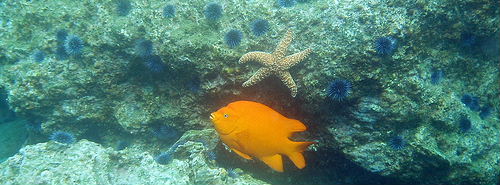
We have removed their main predators- first the otter was driven to extinction in this area a century ago and now we take too many lobster and sheephead fish.
 There is hope for the balance to be restored. The new Laguna Beach State marine reserve will protect most of Laguna’s coast. Marine reserves are no-take zones. This will allow the lobster and sheephead to increase in both numbers and size and hopefully keep the urchin population in check. I know I’m looking forward to observing (through a dive mask) the restoration of Laguna’s marine habitat continue and hopefully accelerate with the implementation of the new marine reserve.
There is hope for the balance to be restored. The new Laguna Beach State marine reserve will protect most of Laguna’s coast. Marine reserves are no-take zones. This will allow the lobster and sheephead to increase in both numbers and size and hopefully keep the urchin population in check. I know I’m looking forward to observing (through a dive mask) the restoration of Laguna’s marine habitat continue and hopefully accelerate with the implementation of the new marine reserve.
What changes have you noticed as the kelp forest has recovered? Please share your observations in the comments.
Info on Giant Kelp from the Monterey Bay Aquarium
Fishes of the Kelp Forest from the Birch Aquarium
Tips on Free Diving in Kelp
In watching seals and otters swim through the kelp effortlessly and without incident, we can learn a valuable lesson about being as streamlined as possible while diving. The problem for divers usually comes when they snag items that are not streamlined with the rest of their bodies. The most notorious culprits are dive knives, fin buckles, and snorkels. Read more.


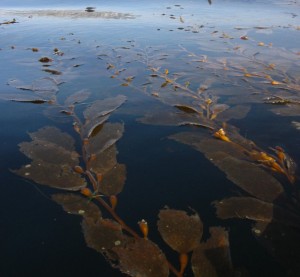
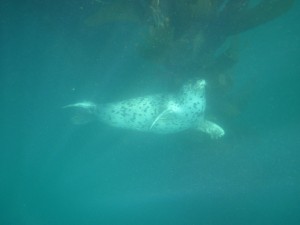
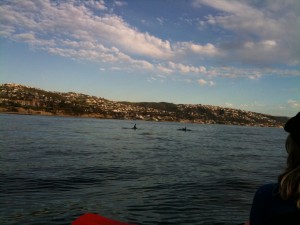
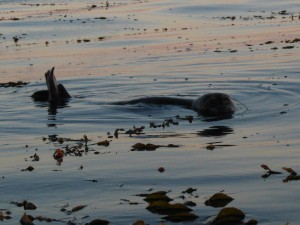
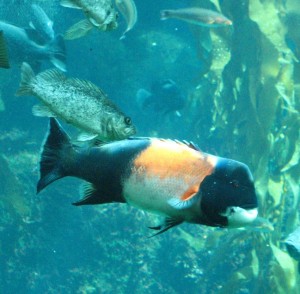


June 4, 2011 at 5:52 pm
Very nice work. Splendid and informative journalism with great photos.
June 5, 2011 at 5:29 pm
Awesome pictures! I can’t wait for my personal tour!